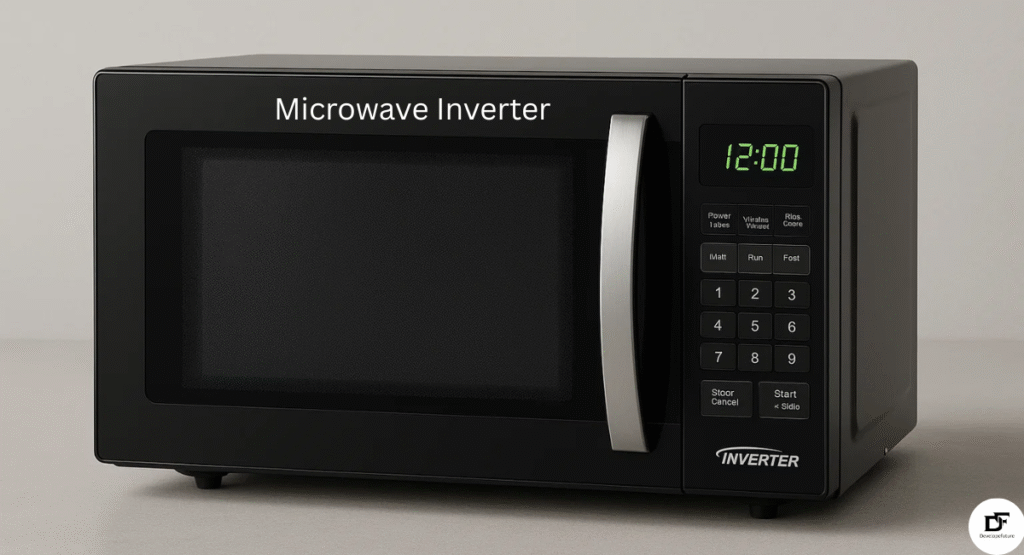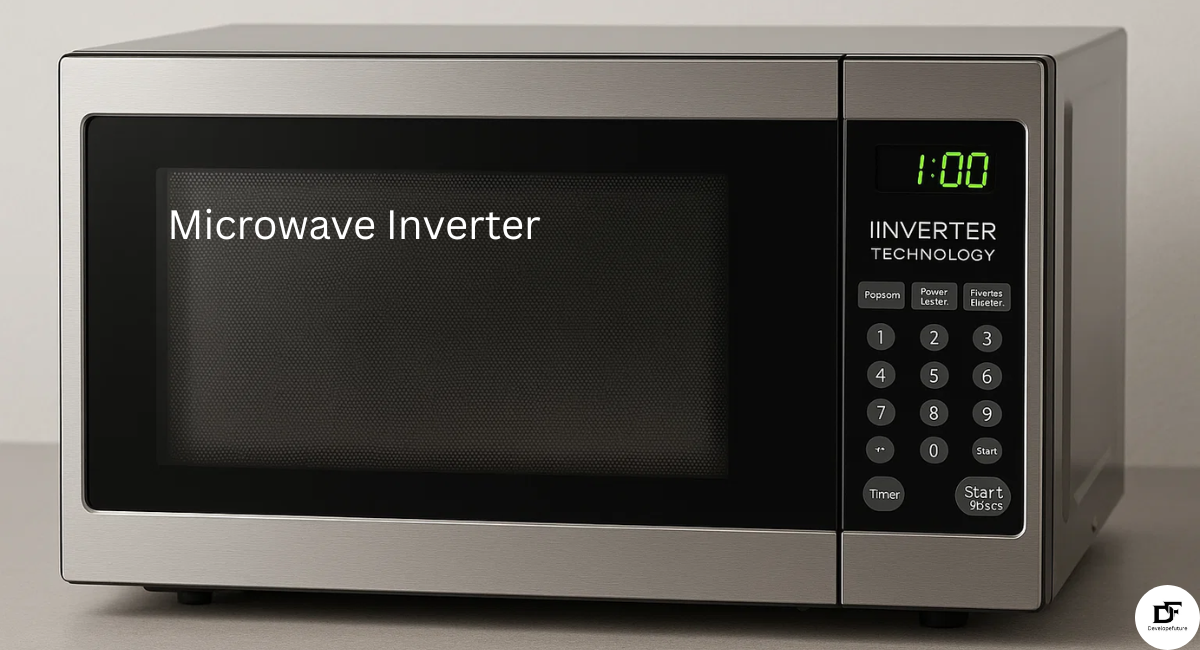A microwave with an inverter technology is a modern evolution of the traditional microwave oven, unlike conventional models. Those who rely on a transformer to regulate power. Microwave with an Inverter uses advanced circuitry to deliver continuous and consistent energy. This results in more precise cooking, heating, and defrosting. It is making them an increasingly popular choice for households. This microwave with an inverter avoids the start-stop bursts of power. That often causes uneven cooking.
The purpose of a microwave with an inverter technology is to maintain a steady cooking temperature. Throughout the entire process. Traditional microwaves cycle between full power and no power. This can leave food unevenly heated or overcooked in certain areas. Microwave with an inverter adjust their power delivery seamlessly. It ensures that food is heated thoroughly and consistently. This advancement saves time. It also improves cooking quality for everyday meals.
Table of Contents
How they differ from traditional microwaves and whether they’re worth considering
The primary difference between a microwave with an inverter and a traditional microwave lies in how they regulate power. Conventional models work on an on-and-off mechanism. Which means when you select 50% power. The microwave alternates between full power and zero power. A microwave with an inverter can truly operate at 50% power by continuously delivering half the energy. This allows for smoother cooking results without overcooked edges or cold spots.
When considering whether a microwave with an inverter is worth buying. It’s important to look at cooking habits. For those who cook or reheat food frequently and value consistent results. A microwave with an inverter offers significant advantages. While they tend to be slightly more expensive than traditional models, they offer efficiency, energy savings. And also improved cooking performance often justifies the cost. For households seeking precision, they are a worthy upgrade.

How do microwave with inverter work
A microwave with an inverter works by replacing the bulky transformer with an electronic inverter circuit. This circuit converts incoming electrical power into a steady stream of energy. That can be finely adjusted. The microwave with an inverter maintains a consistent energy flow. That adapts to the chosen power level. This is particularly effective. When cooking delicate foods. Such as fish or custards, which require precise heat control.
Instead of cycling between extremes of heat, the inverter maintains the exact power setting throughout the cooking process. This avoids temperature fluctuations and ensures even heating across the dish. For example, when defrosting meat. The microwave with an inverter can gently thaw it without accidentally cooking the edges. A common issue with traditional models. This controlled process makes microwaves with an inverter ideal. For a wide variety of cooking needs.
Inverter vs conventional microwave: What’s the difference?
The most noticeable difference between an inverter and a conventional microwave is consistency. Conventional microwaves are prone to uneven cooking because of their cycling power output. This often leaves hot and cold patches in food. A microwave with an inverter continuously regulates power, creating smoother results across all types of dishes. This difference is particularly useful when preparing meals that need delicate temperature control.
Another distinction is in efficiency and energy use. Microwaves with an inverter generally consume less electricity. And cook food faster because they don’t waste energy in the stop-and-start cycles of conventional models. They also tend to be more compact in design, thanks to the absence of a large transformer. While conventional microwaves remain cheaper upfront. A microwave with an Inverter technology pays off in better performance and long-term benefits.

What are the benefits of a microwave with an inverter microwave?
One of the biggest benefits of an inverter microwave is its ability to cook food evenly. By delivering consistent power, it eliminates the frustration of biting into a hot outer layer only to find the inside still cold. This makes it especially useful for reheating leftovers or defrosting frozen foods. Without compromising texture or taste. Families who cook daily will notice the improvement immediately.
Another major benefit is energy efficiency. Because microwaves with an Inverter use power more intelligently. They often cook food faster while consuming less electricity. This not only reduces energy bills. But also contributes to a more sustainable kitchen. Their ability to handle delicate cooking tasks. Like simmering sauces or softening butter, they make them more versatile than traditional microwaves.
Which functions do a microwave with an inverter perform similarly to conventional models?
Despite their advanced technology, a microwave with an inverter still shares many similarities with conventional models. They can reheat leftovers, defrost frozen items, and cook basic meals with ease. Users can still expect standard functions. Such as popcorn settings, beverage heating, and quick defrost options. They operate much like the microwaves most households are already familiar with.
The key difference is not in the available functions but in the quality of execution. For example, both types can defrost chicken. But a microwave with an inverter will do so without partially cooking the edges. Likewise, both can heat a bowl of soup. But the inverter model will ensure consistent warmth throughout. Essentially, a microwave with an inverter performs the same tasks but with greater precision and reliability.

Precise and Consistent Cooking
Precision is one of the hallmarks of a microwave with an inverter technology. Instead of exposing food to fluctuating power levels. The microwave applies steady heat at the selected setting. This results in more reliable cooking outcomes, especially for dishes that demand accuracy. Whether it’s melting chocolate or cooking vegetables. The process is smoother and less likely to cause burning or uneven heating.
Consistent cooking also helps preserve food quality. Overheating can alter the texture or dry out meals. While undercooking can leave cold centers. A microwave with an inverter strikes a balance. By delivering its right amount of power continuously. This ensures that food not only cooks evenly. But also retains its flavor and nutritional value. For home chefs, this is a significant advantage over traditional microwaves.
How Inverter Technology Improves Cooking
Inverter technology improves cooking by eliminating the guesswork. That often comes with traditional microwaves. Instead of constantly stopping to stir or rotate food. Users can rely on even heating from start to finish. This is particularly helpful. When cooking items that must be gently treated, like fish fillets or baked custards. The controlled heating process enhances both texture and taste.
Another way inverter technology improves cooking is by expanding versatility. Tasks that were once challenging in a microwave, such as simmering sauces or steaming vegetables, are now achievable with better results. The steady power flow ensures that delicate dishes aren’t ruined by sudden bursts of heat. This technology transforms the microwave from a simple reheating tool into a more capable kitchen appliance.

Space-Saving Design
One often-overlooked benefit of inverter microwaves is their compact design. Because they use inverter circuitry instead of a large transformer. Manufacturers can design slimmer, more space-efficient units. This makes them ideal for modern kitchens, apartments, or places where counter space is limited. Despite their smaller size, they often provide the same or even larger cooking capacity.
The space-saving design also contributes to portability and ease of installation. Unlike bulky traditional models, microwaves with inverters can be placed in tighter spaces without compromising performance. This balance of efficiency and size makes them especially appealing to younger households and students. And professionals who need high performance in a compact appliance.
Are inverter microwaves more cost-effective to run?
Microwaves with inverters are generally more cost-effective to run. Because they use energy more efficiently. By maintaining steady power instead of cycling between high and low bursts. They reduce electricity consumption. This efficiency is noticeable when cooking larger portions or running the microwave frequently. Over time, these savings can offset the slightly higher buy cost.
Additionally, inverter microwaves reduce cooking times for many dishes, further conserving energy. For households conscious of their utility bills or environmental impact. This makes them an attractive option. While the upfront price may be higher than a conventional microwave. The long-term operating costs are often lower, making them a smart investment in the long run.

The importance of power levels when using a microwave
Power levels play a critical role in microwave cooking. As they determine how much energy is applied to the food. In conventional microwaves, selecting 50% power means the oven alternates between full power and zero power. Which often leads to uneven results. Microwaves with inverters can truly deliver 50% power continuously. It is making low-power cooking much more effective.
This precision makes power levels more meaningful in inverter models. Foods that require gentle heating. Such as melting chocolate or reheating bread, benefit greatly from consistent low power. Without this capability, traditional microwaves risk burning delicate foods. Who value versatility and control, microwaves with inverters make power settings a more reliable tool.
Which Brands Make Inverter Microwaves?
Several leading appliance brands manufacture inverter microwaves, making them widely available to consumers. Panasonic is often credited with pioneering the technology. And it continues to lead in this area. Other well-known brands such as LG, Sharp, Samsung, and Breville also offer a variety of microwave with inverter models. These companies compete by offering different sizes and features. Also price points to suit different households.
Availability of inverter microwaves has grown rapidly in recent years. Many retailers now carry models at various price levels. It is ensuring options for budget-conscious buyers and those seeking premium appliances. With many trusted brands producing them. Consumers have the flexibility to choose a microwave. That matches both their cooking needs and aesthetic preferences.
Do inverter microwaves interfere with WiFi?
There is a common misconception that inverter microwaves interfere with WiFi signals. While all microwaves operate using electromagnetic radiation. Modern inverter models are designed with shielding to minimize interference. In most cases, they should not disrupt home WiFi networks. Any interference that does occur is usually minor and temporary. It is often noticeable only when the microwave is actively running.
It’s worth noting that interference, if present, is not unique to inverter technology. Traditional microwaves can also cause slight disruptions due to the frequency they use. With improvements in design and shielding, these issues are much less common today. For most users, WiFi performance will not be affected by a microwave with an inverter .
How long do inverter microwaves last?
The lifespan of an inverter microwave typically ranges between 7 to 10 years. It depends on usage and maintenance. Factors such as build quality, frequency of use, and care influence longevity. Reputable brands often design their models to be durable and reliable. It is giving consumers confidence in long-term performance. Proper maintenance, such as keeping the interior clean, can also extend life.
Compared to conventional models, microwaves with inverters have fewer bulky mechanical parts. Which can reduce wear and tear. As with any electronic device, components may degrade over time. Replacing older units after a decade is common, especially if performance declines. With good care and moderate use. A microwave with an inverter can remain efficient. And dependable kitchen appliances for many years.
FAQ’s
Are inverter microwaves safer than conventional models?
Yes, inverter microwaves are safe and designed with advanced technology that ensures consistent energy delivery, minimizing overheating risks.
Can I cook the same recipes in an inverter microwave?
Absolutely. Inverter microwaves perform the same tasks as conventional ones. But with greater precision and consistency.
Do inverter microwaves need special cookware?
No, they use the same microwave-safe containers as traditional models. Glass, ceramic, and microwave-safe plastics are suitable.
Are inverter microwaves worth the higher cost?
Yes, especially for frequent users. Their efficiency, better cooking results, and durability often justify the investment.
Can inverter microwaves replace ovens?
While versatile, microwaves with inverters cannot fully replace conventional ovens. But they do complement them by handling reheating, defrosting, and light cooking tasks.
Conclusion
Microwaves with inverter technology represent a significant step forward in kitchen appliances. By replacing traditional transformers with advanced circuitry. They deliver consistent power, precise cooking, and improved energy efficiency. This makes them superior in handling. Everyday cooking tasks while ensuring food is evenly prepared.
From reheating leftovers to preparing delicate dishes. Microwaves with inverters outperform their conventional counterparts in both quality and speed. They may come with a higher upfront cost. But the long-term benefits in efficiency and reliability. Also convenience makes them a worthwhile investment. For modern households seeking smarter. More efficient appliances, inverter microwaves are a clear choice.

